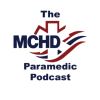We love nothing more than to tackle dogma with evidence on the MCHD Paramedic Podcast. In this episode, Casey Patrick, MD, FAEMS, assistant medical director for the Montgomery County Hospital District EMS, is joined by Williamson County and Marble Falls Area EMS Medical Director, Jeff Jarvis, MD, to discuss his recent prehospital emergency care manuscript, “Using Red Lights and Sirens for Emergency Ambulance Response: How Often are Potentially Life-Saving Interventions Performed?”, looking at the incidence of lifesaving interventions performed by EMS following a red lights and sirens response.
Why even look into this? Everyone knows that responding emergency traffic saves lives right? The existing evidence suggests otherwise, however, with red lights and sirens responses showing no change in patient mortality. Additionally, they only save 90 seconds in urban EMS settings, while also increasing the risk for vehicle crashes. This study’s objective was to add to the existing body of RLS research by looking at how many times a life-saving intervention is performed by EMS following an emergency response.
Dr. Jarvis and his research partners first had to come up with a list of potential life-saving interventions, which obviously leaves room for debate. However, they did an excellent job of including all potential life-saving interventions, even including time-sensitive emergency pre-alerts (STEMI/stroke/trauma/sepsis).
What did they find? In the ESO data set used containing almost 4,000,000 red lights and sirens responses from over 1,000 EMS agencies, potential life-saving interventions were performed in only 6.9% of scene responses.
What does this mean? The answer is multi-faceted and likely service specific. This should serve as a stimulus for all of us to look at our own red lights and sirens data in an effort to reduce unneeded emergency responses, while still trying to target time-sensitive situations.
Read next: 4 lights and sirens safety tips


